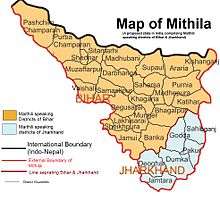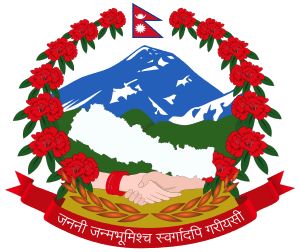Maithil
 Location of the Mithila region in Nepal
 | |
| Regions with significant populations | |
|---|---|
| India |
12,179,122 (2001 Census of India)[1] [2] |
| Nepal |
3.1 million (2011 Census)[3] [4] |
| Languages | |
| Maithili, Hindi and English.[5] | |
| Religion | |
| Mainly Hinduism with a minority following Islam | |
The Maithil (Devnagri: मैथिल, Tirhuta: মৈথিল) are the native speakers of the Maithili language indigenous to the Mithila region, which is now divided between the Mithila, India (Northern Bihar) and Mithila, Nepal (eastern Terai).
Region
Nepal
Maithils are the indigenous speakers of the Nepalese Federal State of Mithila. The Maithil is the largest Indigenous Nepali ethnic group. Most of the region from Jhapa to Parsa in Nepal (centered around Janakpur, in southeastern Nepal) form modern Mithila. This area was known as the kingdom of Videha, with its capital at Janakpur (or Mithila Nagari). The kingdom appears in the Ramayana; according to it and other ancient texts, it is the birthplace of Hindu Goddess Sita and Janaka.
India
Maithils are natives of districts south of the Ganges near Bhagalpur and Monghyr, most of North Bihar, Darbhangā-Madhubani and along Indo-Nepal border. All castes living in Indian Mithila and speaking Maithili language are Indian Maithils.
Ethnicities and Castes
Many ethnic groups and castes inhabit the Mithila region, these include Maithil Brahmins, Rajputs, Bhumihars, Kayasthas, Ahirs, Kurmis, Koeris, Baniyas and many more. [6]
Language
The common language of Maithil people is Maithili , which is the second national language of Nepal elisted in the Eighth Schedule of the Indian Constitution and the Interim Constitution of Nepal. It is an ancient language, from which Nepali, Bengali and related scripts have evolved. The oldest example of this Mithilakshar or Tirhuta script is a Shiva temple inscription in Tilkeshwarsthāna (near Kusheshwarsthāna, in Darbhangā district), in which it is mentioned in Eastern Māgadhi Prākrit that the temple was built on "Kāttika sudi" (Kārtika Shukla pratipadā, or the first tithi in the bright half of the Hindu lunar month of Kārtika) in "Shake 125" (AD 203) on the day after Diwāli (still regarded as auspicious for installing an icon in a temple). The script of the inscription is little different from modern Maithili script. However, during the 20th century most Maithili writers gradually adopted Devanagari script for Maithili.[7] Some traditional pandits still use Tirhutā or Mithilākshara script for pātā (ceremonial letters related to important functions, such as marriage). Fonts for this script were developed in 2003. Maithils are descended from an ancient society which has created works of Maithili literature.
Culture
Most of Maithils never went abroad for employment – a life that kept them isolated in their own localities.[8] In this isolation they developed a unique culture free from the influence of adjacent India, or from the mountain and hills groups of Nepal. The most striking aspects of their environment are the decorated rice containers, colorfully painted verandahs and outer walls of their homes using only available materials like clay, mud, dung and grass. Much of the rich design is rooted in devotional activities and passed on from one generation to the next, occasionally introducing contemporary elements such as a bus or an airplane.[9]
Household structure
In the Central Madhesh of Nepal and Bihar of India, most Maithils prefer living in Badaghar called longhouses with big families of many generations, sometimes 40-50 people. All household members pool their labor force, contribute their income, share the expenditure and use one kitchen.[10]
Religious practices
The religious practices of the Maithils are a mixture of orthodox Hinduism and animism. They worship Shakti and Shakti peeths in various forms; some are also Shaivites and Vaishnavites.[11]
Occupation
Maithils are mainly involved in farming, irrigation is one of the most important aspects of the community. Maithils in Eastern Nepal built canals that irrigate thousands of hectares of land. They plant rice, mustard, corn and lentils, but also collect forest products such as wild fruits, vegetables, medicinal plants and materials to build their houses; hunt deer, rabbit and wild boar, and go fishing in the rivers and oxbow lakes. Hundreds of years ago, without using any sophisticated tools, they built hundreds of kilometers of irrigation canals in the Jhapa and Morang districts of Nepal. An irrigation canal could be used by several villages. Its water and diversion works need to be managed fairly. As a token of respect, the community members may also help them in farming for a day free of cost.
Maithil Brahmins
Maithil Brahmins are a Hindu Brahmin community of Nepal and India. They are one of the five Pancha-Gauda Brahmin communities.[12] They are also noted for panjis, the extensive genealogical records maintained for the last twenty-four generations.
Nepal bombing
On 26 April 2012, the Unified Communist Party of Nepal (Maoist) submitted a proposal for 11 federal units in Nepal in which Nepalese Mithila was not mentioned. The proposal was opposed by local Nepalese residents,[13] who submitted a memorandum to Mithila district headquarters requesting a Mithila federal unit in Nepal. A signature campaign was launched throughout the region in which local residents actively participated.[14] On 30 April, local Maithils were conducting a peaceful protest on Ramananda Chowk in Janakpur. About 10 am, the protest was bombed; five people were killed, three more died later and more than forty were injured.[15] Maithil actress Anju Jha was one of those killed in the bombing; she had become popular in Mukhiyaa Jyu several months earlier.
Later that day a little-known armed political group, Janatantrik Terai Mukti Morcha (Democratic Terai Liberation Front), claimed responsibility to local media in a text message. Rajan Mukti was the primary suspect.[16] The blast in Janakpur and its victims angered local residents, who protested peacefully.
Cross-border regionalism
Mithila regionalism unites Maithils of Nepal and Maithil of India from both sides of international border. Since they share a common history, language, culture, ethnicity, and same origin, they feel part of one Mithila. Positive events on one side of the international border are celebrated on the other side, and negative events are mourned on both sides.[17]
Notable people
Sita, King Janaka, Vishwamitra, Yagyavalkya, Gautama Buddha, Kapil, Kanad, Mandan, Kumarilbhatta, kalidas, Udaynacharya, Jyotirishwar, Vidyapati, Chanda Jha, Baidyanath Mishra 'Yatri"/Nagrajuna, Surendra Jha 'Suman', Dr. Jaykant Mishra are the notable Maithils of Ancient and Modern times.
The Malla dynasty of Kathmandu Valley are said to have Maithil origin as they were noted for their fluency in speaking Maithili in their Courts, administrations, various dramas and earlier references from Swayambhu Puran and other folklore of centuries back.[18][19] [20] Raja Lorikruled in Indian parts of Mithila. Lord Mahavir, 24th Tirthankar was born in southern part of Indian Mithila, north of Ganga in Vaishali where flourished first historically accepted democracy though after 57th Janak, democaracy prevailed in northern, Nepali parts of Mithila as per Sanskrit texts and folklore. Guatama Buddha, though born in present Nepal Terai at Lumbini in his mother's ancestral place as per tradition first child is born there, he was a descendant of Vrijji dynasty of Vaishali; even Charvak born near Begusarai in Indian Mithila at Chak_Samho of a Gujarati parentage (his father was said to be 'rajguru,' of one Jank Devrat). Ram Baran Yadav, Parmanand Jha, among Chief Ministers of Bihar feom Mithila region wereKrishna Singh, Deep narayan singh, Binodanand Jha, Satish prasad Singh, B.P.Mandal, Bhola Paswan 'Shastri', Karpoori Thakur, Kedar Pandey, Jagannath Mishra, Ramsundar Das, Bhagwat Jha'Azad' and among Mithila statehood activists Lakshman Jha, Babu janki Nandan Singh, Dhanakar Thakur, Jaykant Mishra, Tarakant Jha, democratic crusader in Nepal Durgananda Jha, singer Udit Narayan Jha, Sharda Sinha.
References
- ↑ http://www.censusindia.gov.in/Census_Data_2001/Census_Data_Online/Language/gen_note.html?drpQuick=&drpQuickSelect=&q=maithili+2001
- ↑ Dr. Arun C. Mehta. "District-wise Population (Census) Data: 2001 Census, India". Educationforallinindia.com. Retrieved 2013-07-18.
- ↑ Dr. Arun C. Mehta. "Maithil Population (Nepali Census) Data: 2011 Census, Nepal". Educationforallnepal.com. Retrieved 2013-07-18.
- ↑ "Census of Nepal 2011" (PDF). UNFPA. Archived from the original (PDF) on June 10, 2014. Retrieved 2013-09-22.
- ↑ "Demographics of Maithil population of Nepal".
- ↑ https://books.google.co.uk/books?id=A0i94Z5C8HMC&pg=PA33&dq=rajputs+mithila&hl=en&sa=X&ved=0ahUKEwjliZrsydDQAhXoBsAKHWGcAtEQ6AEIGzAA#v=onepage&q=brahmins%20mithila&f=false
- ↑ Chaudhary, Pranava (May 22, 2011). "US scholar's project of encoding Tirhuta script into digital media". The Times of India. Bennett, Coleman & Co. Ltd. Retrieved 26 July 2013.
- ↑ Gurung, G.M. (1992). "Socioeconomic Network of a Terai Village: An account of the Maithils of Sunsari" (PDF). Contributions to Nepalese Studies, Vol. 19, No. 1.
- ↑ Meyer, K. W., Deuel, P. (1997). "The Maithils of the Terai-Madhesh". Indigo Gallery, Kathmandu. Retrieved 2006-12-07.
- ↑ Lam, L. M. (2009). "Park, hill migration and changes in household livelihood systems of Maithils in Central Nepal." (PDF). University of Adelaide.
- ↑ Makhan Jha (1 January 1997). Anthropology of Hindu Kingdom of Nepal: A Study in Civilizational Perspective. M.D. Publications Pvt. Ltd. pp. 38–. ISBN 978-81-7533-034-4.
- ↑ Venkatesa Iyengar (1932). The Mysore of Brahmins of Mithila region of Nepal. Mittal Publications. p. 301. GGKEY:XFC5XHQ9E3J.
- ↑ "BBC Nepali - समाचार - माओवादी संघीय प्रस्तावप्रति आपत्ति". Bbc.co.uk. 1970-01-01. Retrieved 2013-09-22.
- ↑ Himalayan News Service (28 April 2012). "Locals oppose Mithila division". The Himalayan Times. Retrieved 3 August 2013.
- ↑ "4 killed in nepal bomb blast 9199126". Jagran.com. 2013-09-17. Retrieved 2013-09-22.
- ↑ Manesh Shrestha (April 30, 2012). "5 Nepali Maithils died in Nepal blast, little know group claims responsibility". The Times of India. Retrieved August 3, 2013.
- ↑ "Maithils of India mourned for Maithils of Nepal who losts lives in Janakpur bombing 9205721". Jagran.com. 2012-05-02. Retrieved 2013-09-22.
- ↑ "Origin of Malla dynasty in Nepal".
- ↑ "Newari language and Maithili literature of Nepal".
- ↑ "Maithil wives of Kings of Malla dynasty and the Maithili literature expansion in Kathmandu Valley".
